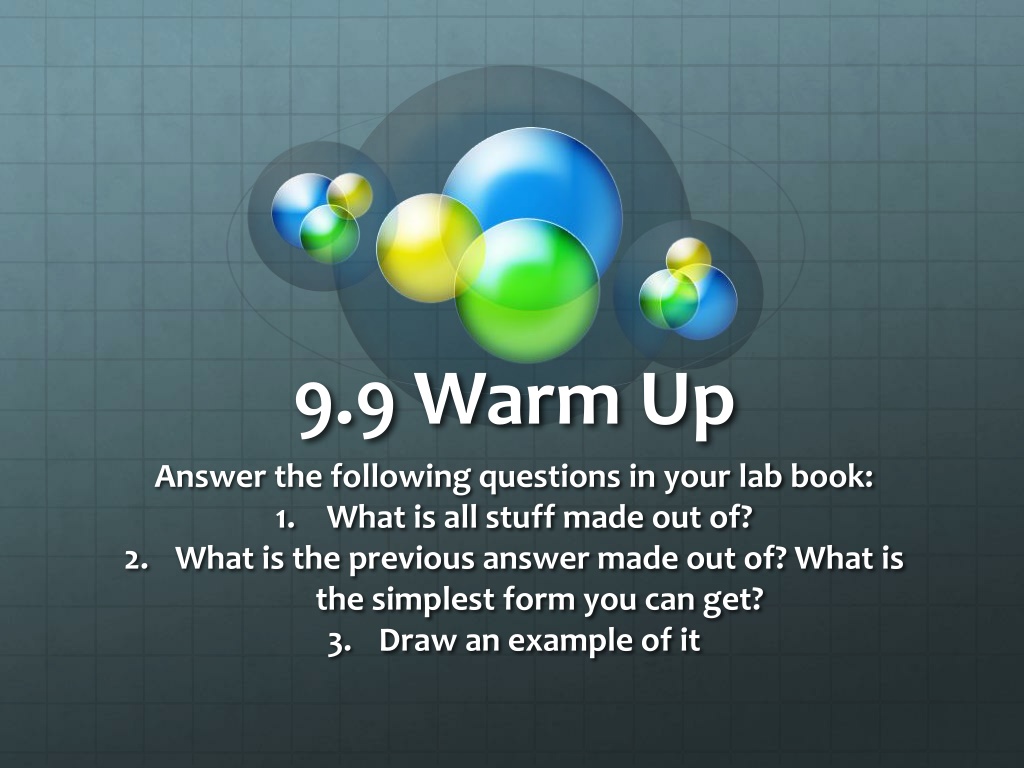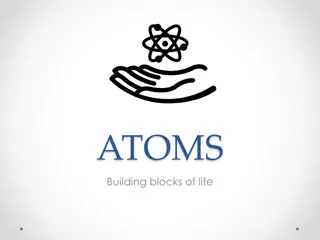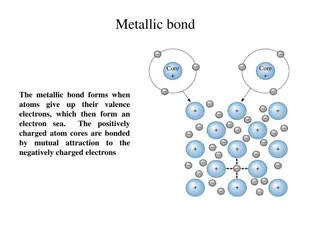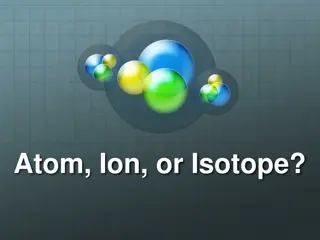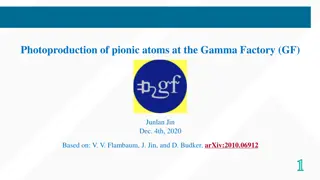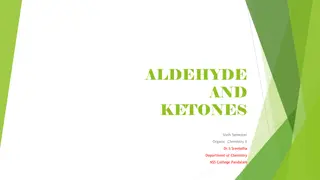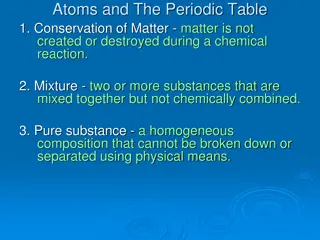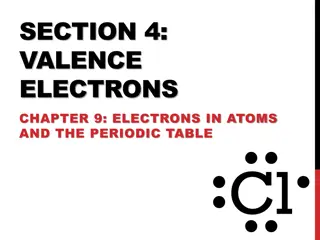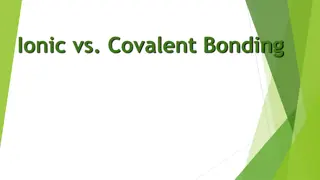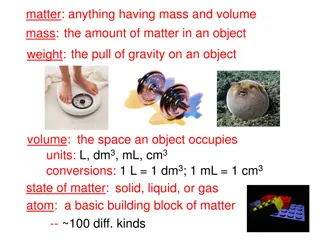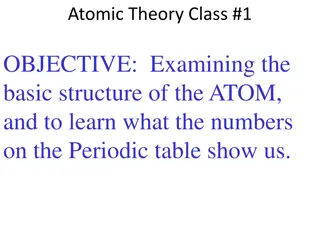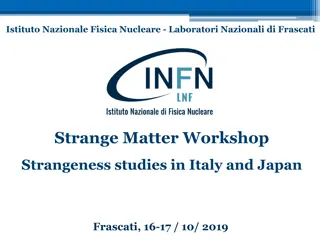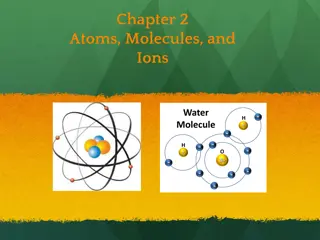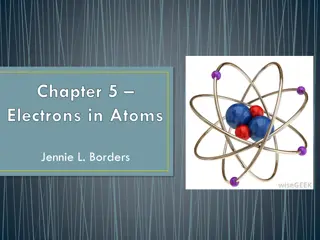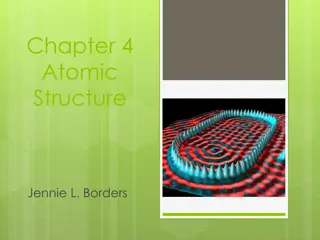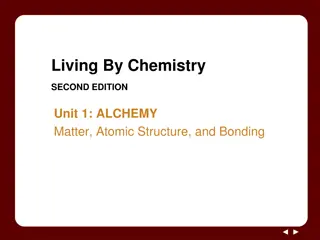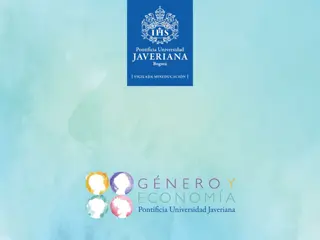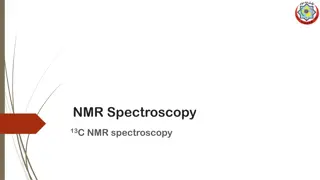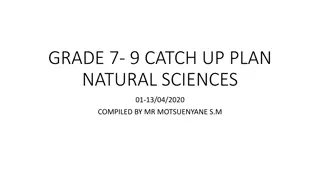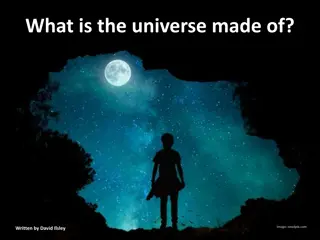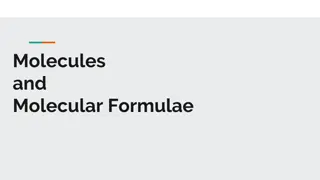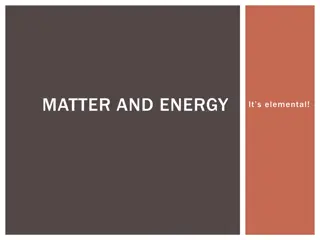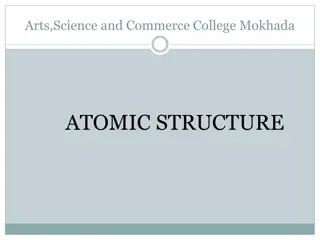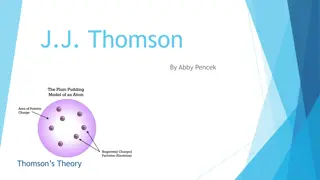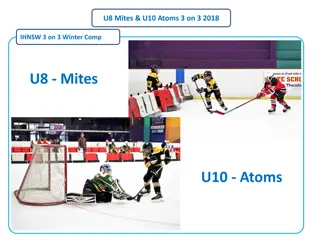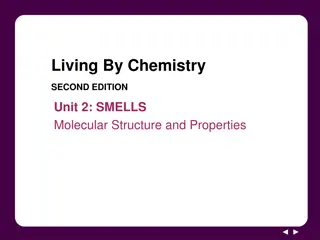Understanding Atoms: From Structure to Models
Explore the fundamental building blocks of matter - atoms. Discover what materials are made of, delve into atomic theories, examine Bohr models, and learn about the intricate components such as protons, neutrons, and electrons. Engage in a journey through the microscopic world of atoms and their significance in our understanding of the physical universe.
Download Presentation

Please find below an Image/Link to download the presentation.
The content on the website is provided AS IS for your information and personal use only. It may not be sold, licensed, or shared on other websites without obtaining consent from the author. Download presentation by click this link. If you encounter any issues during the download, it is possible that the publisher has removed the file from their server.
E N D
Presentation Transcript
9.9 Warm Up Answer the following questions in your lab book: 1. What is all stuff made out of? 2. What is the previous answer made out of? What is the simplest form you can get? 3. Draw an example of it
Announcements 9.9 Research Papers turned into back tray 9.9 IRB Paperwork due make sure it is all attached with a paperclip & handed to me 9.12 Materials & Methods due online 9.19 Journal Check & Experimental Design
Warm Up & Atoms http://learn.genetics.utah.edu/content/cells/scale/ So what does an atom really look like? How small is it? http://ed.ted.com/lessons/just-how-small-is-an-atom
Group Presentations Explain & expound on one of the atomic theories that led to our understanding of the atom today. Include: the name of the theory Scientist How they came up with the theory (key facts) Diagram or model of their atom
Clubs Studying: Independent studying Music is ok Reading or working on assignments Computers wait for me to get Science Fair ppl finished
9.11 Warm Up answer the following questions as best as possible 1. Draw a simple Bohr model for one the following atoms: 2. What is the atomic number? 3. What is the atomic mass? 4. How many protons, neutrons & electrons does it have?
1. Draw a simple Bohr model for the following atom: 1. What is the atomic number? Atomic # = 6 2. What is the atomic mass? Atomic mass = 12.011 amu 1. How many protons, neutrons & electrons does it have? P = 6, N = 6, E = 6
Announcements 9.9 Research Papers turned into back tray 9.9 IRB Paperwork due make sure it is all attached with a staple, turn into tray 9.12 Materials & Methods due online 9.19 Journal Check & Experimental Design
Scale 1-4 Do you know how to apply an electron dot diagram to C & H atoms? Could you relate it to ionic bonding or covalent bonding?
Learning Scale Structure of Matter 4. I can describe matter and no only the characteristics of the atom but how it relates to other atoms with bonding and properties 3. I can describe matter and the characteristics of an atom 2. I can describe the atom or matter but not how they relate 1. I know about atoms but need to review what it is composed of
The Atom What would happen if your idea of the atom was wrong? Video Early Greeks - Democritus
Make this Data Table Researcher Instrument Name of Model Sketch of Model Major Discovery/ Idea
Modern Atomic Theory All matter is composed of atoms Atoms cannot be subdivided, created, or destroyed in ordinary chemical reactions. However, these changes CAN occur in nuclear reactions! Atoms of an element have a characteristic average mass which is unique to that element. Atoms of any one element differ in properties from atoms of another element
Dalton Billiard Ball Model All matter is composed of indivisible particles called atoms. All atoms of the same elements are alike. Atoms of different elements different. Compounds are formed by a combination of 2 or more atoms Atoms cannot be created or destroyed
Thomsom Video about Cathode Ray Video on the Explanation of the Plum Pudding Model http://culturesciences.chimie.ens.fr/node/1230
Thomsons Findings Thomson concluded that the negative charges came from within the atom. A particle smaller than an atom had to exist. The atom was divisible! Thomson called the negatively charged corpuscles, today known as electrons. Since the gas was known to be neutral, having no charge, he reasoned that there must be positively charged particles in the atom. But he could never find them.
Thomsons Atomic Model Thomson believed that the electrons were like plums embedded in a positively charged pudding, thus it was called the plum pudding model.
Rutherfords Gold Foil Experiment Alpha ( ) particles are helium nuclei Particles were fired at a thin sheet of gold foil Particle hits on the detecting screen (film) are recorded
Rutherfords Findings Most of the particles passed right through A few particles were deflected VERY FEW were greatly deflected Conclusions: The nucleus is small The nucleus is dense The nucleus is positively charged
This could only mean that the gold atoms in the sheet were mostly open space. Atoms were not a pudding filled with a positively charged material. Rutherford concluded that an atom had a small, dense, positively charged center that repelled his positively charged bullets. He called the center of the atom the nucleus The nucleus is tiny compared to the atom as a whole. Rutherford reasoned that all of an atom s positively charged particles were contained in the nucleus. The negatively charged particles were scattered outside the nucleus around the atom s edge.
Bohr Model Orbits for electrons Energy Levels
Wave/Cloud Model 1920 s X-Ray Diffraction Noticed electrons behaved like particles & waves Electrons traveled in areas of high probability in areas called ORBITALS or CLOUDS 1932 Chadwick Discovered the neutron
Atom Definition Atomic model = consists of a nucleus that contains protons and neutrons, surrounded by a cloudlike region of moving electrons
Electron Cloud Indivisible Electron Nucleus Orbit Greek X Dalton X Thomson X Rutherford X X Bohr X X X Wave X X X
Atomic Particles Particle Electron Charge Mass # -1 Location Electron cloud Nucleus Nucleus 0 Proton Neutron +1 0 1 1
Atomic Number Atomic number (Z) of an element is the number of protons in the nucleus of each atom of that element. Element # of protons Atomic # (Z) Carbon 6 6 Phosphorus 15 15 Gold 79 79
Mass Number Mass number is the number of protons and neutrons in the nucleus of an isotope. Mass # = p+ + n0
Isotopes Isotopes are atoms of the same element having different masses due to varying numbers of neutrons. Isotope Protons Electrons Neutrons Nucleus Hydrogen 1 (protium) 1 1 0 Hydrogen-2 (deuterium) 1 1 1 Hydrogen-3 (tritium) 1 1 2
Atomic Masses Atomic mass is the average of all the naturally occurring isotopes of that element. Isotope Symbol Composition of the nucleus % in nature Carbon-12 12C 6 protons 6 neutrons 98.89% Carbon-13 13C 6 protons 7 neutrons 1.11% Carbon-14 14C 6 protons 8 neutrons <0.01% Carbon = 12.011
Mass Number Mass number is the number of protons and neutrons in the nucleus of an isotope. Mass # = p+ + n0 Nuclide Oxygen - - Arsenic 75 p+ n0 10 42 e- Mass # 18 8 8 18 33 15 33 75 - 31 Phosphorus 15 31 16
